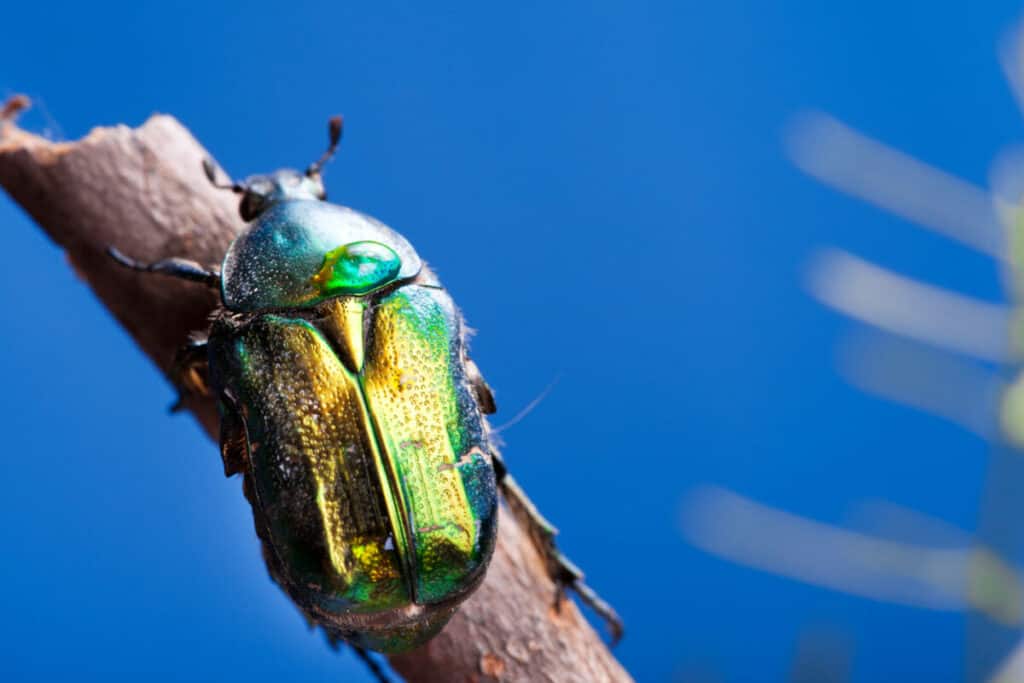Are you noticing small bugs munching away at your vegetable plants? Chances are, they’re Japanese beetles!
These pesky little insects can do a lot of damage to your precious produce if not taken care of quickly.
In this blog post, we’ll discuss what Japanese beetles are, how to identify them, and the best ways to protect your vegetable plants from them.
What are Japanese beetles?
Japanese beetles are small, metallic green-colored insects with copper-colored wings. They have black heads and long antennae, and can range in size from 6mm to 12mm long.
They are most active during the summer months when temperatures are warmest. If left unchecked, these beetles can quickly destroy gardens and other vegetation.
What damage do Japanese beetles cause on plants?
They feed on the leaves of the plant, leaving behind skeletonized foliage and large areas of damage. The larvae, or grubs, feed on the roots of grasses and other vegetation, damaging lawns and fields in their wake.
Japanese beetles also consume flowers, fruits, and vegetables, making them a significant pest for many gardeners. They are known for transmitting several diseases that can weaken and ultimately kill plants.
How to identify Japanese beetles on plants

We can identify Japanese beetles by their metallic green color and copper-colored wings. They have a black head and long antennae, and can range in size from 6mm to 12mm long.
When they are feeding on leaves, Japanese beetles will leave behind skeletonized foliage and large areas of damage. You may also identify their larvae, or grubs, by digging around the roots of your plants. The grubs are white with an orange head capsule.
Read more:
How to get rid of Japanese beetles
Handpick: Japanese beetles can easily be removed by handpicking them off of your plants and dropping them into a bucket of soapy water to kill them.
Use Neem Oil: Neem oil is an organic insecticide that can get rid of Japanese beetles on your plants. Mix 1 teaspoon of neem oil with 1 quart of water in a spray bottle and spray the affected areas.
Use Insecticidal Soap: Insecticidal soaps are formulated to kill soft-bodied insects like Japanese beetles on contact.
Diatomaceous earth: Sprinkling diatomaceous earth around your plants can help get rid of Japanese beetles. This powder comprises fossilized algae and is harmless to humans, pets, and plants but is deadly to insects.
Read more:
- How To Stop Insects Eating Plant Leaves
- How to Use Neem Oil and Save Your Plants
- How To Use Diatomaceous Earth In Potted Plants
- Insecticidal Soap vs Dish Soap for Pest Control
How to prevent Japanese beetles on plants
- Plant resistant varieties of vegetables, such as corn, which are less attractive to beetles.
- Use floating row covers on your vegetable garden to prevent beetles from reaching the plants.
- Remove any weeds or debris around your garden that might provide shelter for Japanese beetles.
- Place traps in your garden to capture adult beetles before they can lay eggs and reproduce.
- Apply beneficial nematodes or milky spore bacteria to kill grubs before they become adults.
Host vegetable plants for Japanese beetles
Japanese beetles feed on a wide range of vegetable plants, including beans, corn, lettuce, peppers, tomatoes and squash.
Natural predators of Japanese beetles
These include birds, such as warblers and bluebirds, ground beetles, spiders, dragonflies, predaceous mites, and various parasitic wasps.
Birds are particularly effective at controlling Japanese beetle populations due to their ability to consume large numbers of the beetles in one sitting.
Ground beetles feed on both the adults and larvae of the Japanese beetle while spiders feed on them as well as other insects.
Predaceous mites attack both the larvae and adult stages while parasitic wasps lay eggs in or near Japanese beetle larvae which then hatch and consume them from within.
References
- https://www.aphis.usda.gov/aphis/ourfocus/planthealth/plant-pest-and-disease-programs/pests-and-diseases/japanese-beetle/japanese-beetle
- https://entnemdept.ufl.edu/creatures/orn/beetles/japanese_beetle.htm
- https://www.almanac.com/pest/japanese-beetles

Fact Checked, Written, and Published by Kevin Rodrigues
Kevin is the founder of Gardening Mentor, a website that aims to teach people to grow their own food in a limited space. As a self-taught gardener, Kevin has spent several years growing plants and creating gardening content on the website. He is certified in Home Horticulture and Organic Gardening from Oregon State University. He has a Post Graduate Diploma in Horticulture and Landscape Gardening from Mumbai University.
Read more
